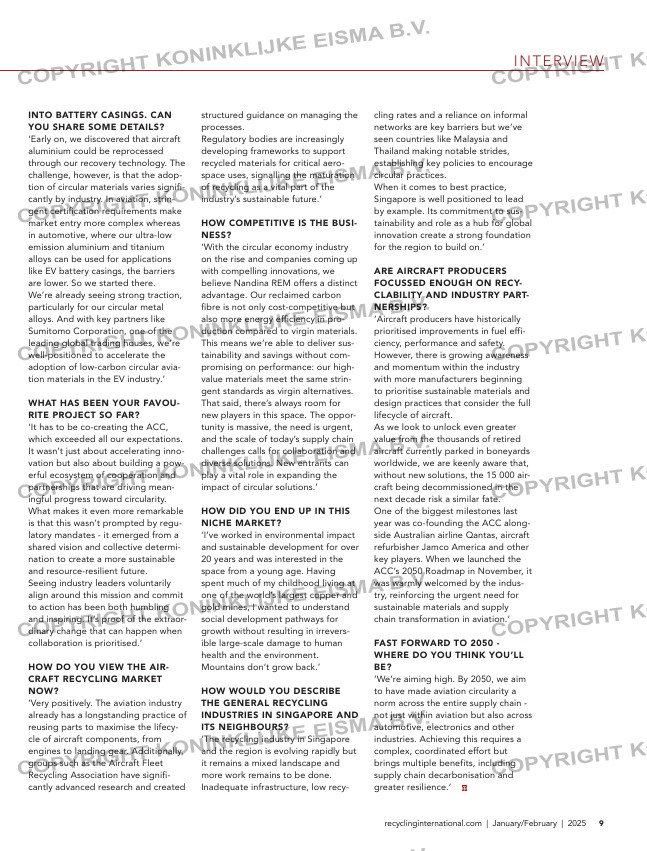Page 9 from: Recycling International Jan/Feb 2025

9recyclinginternational.com | January/February | 2025
INTERVIEW
INTO BATTERY CASINGS. CAN
YOU SHARE SOME DETAILS?
‘Early on, we discovered that aircraft
aluminium could be reprocessed
through our recovery technology. The
challenge, however, is that the adop-
tion of circular materials varies signifi-
cantly by industry. In aviation, strin-
gent certification requirements make
market entry more complex whereas
in automotive, where our ultra-low
emission aluminium and titanium
alloys can be used for applications
like EV battery casings, the barriers
are lower. So we started there.
We’re already seeing strong traction,
particularly for our circular metal
alloys. And with key partners like
Sumitomo Corporation, one of the
leading global trading houses, we’re
well-positioned to accelerate the
adoption of low-carbon circular avia-
tion materials in the EV industry.’
WHAT HAS BEEN YOUR FAVOU-
RITE PROJECT SO FAR?
‘It has to be co-creating the ACC,
which exceeded all our expectations.
It wasn’t just about accelerating inno-
vation but also about building a pow-
erful ecosystem of cooperation and
partnerships that are driving mean-
ingful progress toward circularity.
What makes it even more remarkable
is that this wasn’t prompted by regu-
latory mandates – it emerged from a
shared vision and collective determi-
nation to create a more sustainable
and resource-resilient future.
Seeing industry leaders voluntarily
align around this mission and commit
to action has been both humbling
and inspiring. It’s proof of the extraor-
dinary change that can happen when
collaboration is prioritised.’
HOW DO YOU VIEW THE AIR-
CRAFT RECYCLING MARKET
NOW?
‘Very positively. The aviation industry
already has a longstanding practice of
reusing parts to maximise the lifecy-
cle of aircraft components, from
engines to landing gear. Additionally,
groups such as the Aircraft Fleet
Recycling Association have signifi-
cantly advanced research and created
structured guidance on managing the
processes.
Regulatory bodies are increasingly
developing frameworks to support
recycled materials for critical aero-
space uses, signalling the maturation
of recycling as a vital part of the
industry’s sustainable future.’
HOW COMPETITIVE IS THE BUSI-
NESS?
‘With the circular economy industry
on the rise and companies coming up
with compelling innovations, we
believe Nandina REM offers a distinct
advantage. Our reclaimed carbon
fibre is not only cost-competitive but
also more energy efficiency in pro-
duction compared to virgin materials.
This means we’re able to deliver sus-
tainability and savings without com-
promising on performance: our high-
value materials meet the same strin-
gent standards as virgin alternatives.
That said, there’s always room for
new players in this space. The oppor-
tunity is massive, the need is urgent,
and the scale of today’s supply chain
challenges calls for collaboration and
diverse solutions. New entrants can
play a vital role in expanding the
impact of circular solutions.’
HOW DID YOU END UP IN THIS
NICHE MARKET?
‘I’ve worked in environmental impact
and sustainable development for over
20 years and was interested in the
space from a young age. Having
spent much of my childhood living at
one of the world’s largest copper and
gold mines, I wanted to understand
social development pathways for
growth without resulting in irrevers-
ible large-scale damage to human
health and the environment.
Mountains don’t grow back.’
HOW WOULD YOU DESCRIBE
THE GENERAL RECYCLING
INDUSTRIES IN SINGAPORE AND
ITS NEIGHBOURS?
‘The recycling industry in Singapore
and the region is evolving rapidly but
it remains a mixed landscape and
more work remains to be done.
Inadequate infrastructure, low recy-
cling rates and a reliance on informal
networks are key barriers but we’ve
seen countries like Malaysia and
Thailand making notable strides,
establishing key policies to encourage
circular practices.
When it comes to best practice,
Singapore is well positioned to lead
by example. Its commitment to sus-
tainability and role as a hub for global
innovation create a strong foundation
for the region to build on.’
ARE AIRCRAFT PRODUCERS
FOCUSSED ENOUGH ON RECY-
CLABILITY AND INDUSTRY PART-
NERSHIPS?
‘Aircraft producers have historically
prioritised improvements in fuel effi-
ciency, performance and safety.
However, there is growing awareness
and momentum within the industry
with more manufacturers beginning
to prioritise sustainable materials and
design practices that consider the full
lifecycle of aircraft.
As we look to unlock even greater
value from the thousands of retired
aircraft currently parked in boneyards
worldwide, we are keenly aware that,
without new solutions, the 15 000 air-
craft being decommissioned in the
next decade risk a similar fate.
One of the biggest milestones last
year was co-founding the ACC along-
side Australian airline Qantas, aircraft
refurbisher Jamco America and other
key players. When we launched the
ACC’s 2050 Roadmap in November, it
was warmly welcomed by the indus-
try, reinforcing the urgent need for
sustainable materials and supply
chain transformation in aviation.’
FAST FORWARD TO 2050 –
WHERE DO YOU THINK YOU’LL
BE?
‘We’re aiming high. By 2050, we aim
to have made aviation circularity a
norm across the entire supply chain –
not just within aviation but also across
automotive, electronics and other
industries. Achieving this requires a
complex, coordinated effort but
brings multiple benefits, including
supply chain decarbonisation and
greater resilience.’
Fotobijschrift
KADERKOP
??
08-09_interview.indd 9 29-01-2025 11:22



